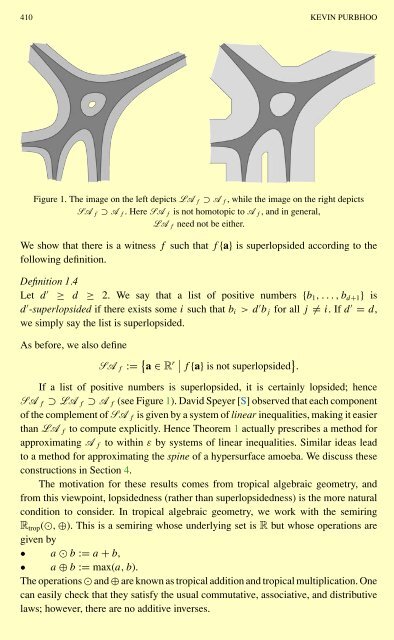A NULLSTELLENSATZ FOR AMOEBAS
A NULLSTELLENSATZ FOR AMOEBAS
A NULLSTELLENSATZ FOR AMOEBAS
You also want an ePaper? Increase the reach of your titles
YUMPU automatically turns print PDFs into web optimized ePapers that Google loves.
410 KEVIN PURBHOO<br />
Figure 1. The image on the left depicts LA f ⊃ A f , while the image on the right depicts<br />
SA f ⊃ A f . Here SA f is not homotopic to A f , and in general,<br />
LA f need not be either.<br />
We show that there is a witness f such that f {a} is superlopsided according to the<br />
following definition.<br />
Definition 1.4<br />
Let d ′ ≥ d ≥ 2. We say that a list of positive numbers {b 1 ,...,b d+1 } is<br />
d ′ -superlopsided if there exists some i such that b i >d ′ b j for all j ≠ i. Ifd ′ = d,<br />
we simply say the list is superlopsided.<br />
As before, we also define<br />
SA f := { a ∈ R r ∣ ∣ f {a} is not superlopsided } .<br />
If a list of positive numbers is superlopsided, it is certainly lopsided; hence<br />
SA f ⊃ LA f ⊃ A f (see Figure 1). David Speyer [S] observed that each component<br />
of the complement of SA f is given by a system of linear inequalities, making it easier<br />
than LA f to compute explicitly. Hence Theorem 1 actually prescribes a method for<br />
approximating A f to within ε by systems of linear inequalities. Similar ideas lead<br />
to a method for approximating the spine of a hypersurface amoeba. We discuss these<br />
constructions in Section 4.<br />
The motivation for these results comes from tropical algebraic geometry, and<br />
from this viewpoint, lopsidedness (rather than superlopsidedness) is the more natural<br />
condition to consider. In tropical algebraic geometry, we work with the semiring<br />
R trop (⊙, ⊕). This is a semiring whose underlying set is R but whose operations are<br />
given by<br />
• a ⊙ b := a + b,<br />
• a ⊕ b := max(a,b).<br />
The operations ⊙ and ⊕ are known as tropical addition and tropical multiplication. One<br />
can easily check that they satisfy the usual commutative, associative, and distributive<br />
laws; however, there are no additive inverses.
















